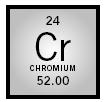Chromium

MELTING POINT:
1,860°C
BOILING POINT
: 2,670°C
DENSITY
: 7.19 g/cm
3
MOST COMMON IONS
: Cr
2+
, Cr
3+
, CrO
4
2−
, Cr
2
O
7
2−
Chromium was first identified in 1797 by the French chemist Louis-Nicolas Vauquelin, who isolated it from crocoite, a mineral also called Siberian red lead. The name for chromium is taken from the Greek chroma , which means "color." This is a fitting name, because chromium compounds are often found in vividly colorful shades of green, red, or yellow. As such, chromium compounds historically have found extensive use as pigments for paints. In contrast, elemental chromium is a shiny, hard, yet brittle, steel-gray metal . Since chromium is not found naturally in its free elemental state, it is usually extracted from chromite, FeCr 2 O 4 .
Perhaps the best-known use of chromium is as a decorative, protective, shiny plating over other metals, with chrome-plated automobile parts being a familiar example. Chromium is also an important alloy component in stainless steel because it makes the steel stronger and more corrosion-resistant. Paint pigments account for more than one-third of all chromium usage each year.
Overall, chromium is the twenty-first most abundant element in Earth's crust. It is usually found in the +2 (e.g., CrO), +3 (e.g., Cr 2 O 3 ), or +6 (e.g., K 2 Cr 2 O 7 ) oxidation states, with chromic oxide, Cr 2 O 3 , being the ninth most abundant compound in Earth's crust. While chromium is considered a necessary micronutrient in human diets, many of its compounds are quite toxic. This is especially true of chromium in the +6 oxidation state, with compounds such as K 2 Cr 2 O 7 being identified as carcinogens. Thus chromium compounds should be handled carefully.
David A. Dobberpuhl
Bibliography
Heiserman, David L. (1992). Exploring Chemical Elements and Their Compounds. Blue Ridge Summit, PA: Tab Books.
Krebs, Robert E. (1998). The History and Use of Our Earth's Chemical Elements: A Reference Guide. Westport, CT: Greenwood Press.
Swertka, Albert (2002). A Guide to the Elements. New York: Oxford University Press.
Comment about this article, ask questions, or add new information about this topic: